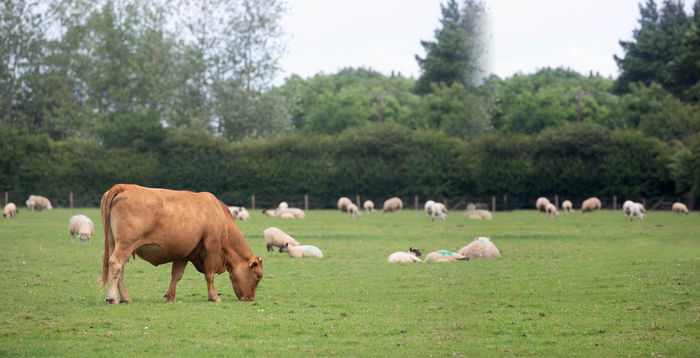With the right management plan in place, grass tetany is preventable for beef, dairy and sheep farmers. Dr Alison Bond, nutritionist for Rumenco, outlines what to include.
As grass growth begins to pick up, beef, dairy and sheep producers need to implement strategic practices to prevent grass tetany, says Dr Alison Bond, nutritionist for Rumenco.
“Grazed grass is a great feed source but very low in dry matter,” she says. “This means some of the nutrient levels are diluted and it can be difficult for animals to eat sufficient levels, in particular, magnesium intake can be low resulting in magnesium deficiency, otherwise known as grass staggers, grass tetany or hypomagnesaemia.”
While all grazing livestock are vulnerable to grass tetany if a magnesium deficiency is present, beef and dairy cows four to eight weeks post-calving and ewes three to four weeks post-lambing are at most risk as energy stores are stressed approaching peak lactation.
“True to being referred to as grass staggers, tell-tale signs of magnesium deficiency are excitement and muscular spasms in stock. Sub-clinical cases typically result in decreased dry matter intakes, milk yields and body condition,” says Dr Bond. “But unfortunately, the first sign of grass tetany is typically a dead animal, often with froth from the mouth and nose and signs of ground paddling.”
Research indicates that 19 percent of dairy farms and 23 percent of suckler beef farms experience grass tetany. In dairy herds, 30 percent of cases result in death, with a conservative cost of approximately £2 million per annum in the UK.
“Grass tetany is a common disease during the spring grass flush that results in loss of animals every year – however, it is completely preventable with the right management in place,” says Dr Bond.
Below, she outlines six management practices to include in a grass tetany prevention plan.
- Offer supplementary salt
At the very least, grazing stock need to be supplemented with salt since the absorption of magnesium from the rumen is dependent upon sodium.
“Research has shown that without adequate sodium in the animal’s blood, the body will grab onto the most available cation, in this case, magnesium, followed by calcium. Therefore, salt licks can be a valuable supplement to ruminants grazing pasture low in sodium to help prevent grass tetany from occurring,” says Dr Bond.
- Minimise use of nitrogen and potassium fertilisers
While salt aids in magnesium absorption, potassium and nitrogen block it.
“High potassium forages or fields that have been treated with nitrogen and potassium fertilisers can imbalance and interfere with magnesium absorption. If you are going to fertilise, then don’t put animals that are at high risk on to them,” says Dr Bond.
High potassium will also negatively affect magnesium uptake by plants and the availability of the forage magnesium to the animal, with recommendations that the potassium level in grass should not exceed 2.5 percent.
- Choose your fields carefully for grazing
Not only will a field’s fertiliser programme impact magnesium levels, so will the age of the ley and species within it.
“Younger, faster growing leys can present more magnesium deficiencies than older, slower growing pastures,” explains Dr Bond. “This risk can be minimised by supplementing with a palatable magnesium source or by allocating new leys to less vulnerable stock until grass growth has slowed down.”
An alternative way to increase the magnesium supply to grazing stock is through the use of clovers, which contain two times the amount of magnesium than grasses.
- Provide daily access to a palatable magnesium source
As a best practice safeguard, grazing stock should be provided daily access to a magnesium supplement during this early grazing period.
According to Dr Bond, it is important magnesium is supplied in a palatable source like a low moisture bucket due to magnesium being very bitter.
Supplementing with a low moisture bucket also allows producers to support livestock in other areas of performance like forage utilisation and trace element supplementation.
“A huge benefit of supplying magnesium through a low moisture bucket is an increase in forage utilisation by upwards of 10 percent. As livestock lick the feed, the increased release of saliva buffers the highly concentrated levels of sugar and energy flowing to the rumen. This in turn helps cattle and sheep make the most of the available forage on offer,” explains Dr Bond. “Fortified with minerals, vitamins and trace elements, they also work to support animal health and performance – making them a multi-purpose product.”
Producers can also select product formulations to best support other nutritional requirements for stock. SUPAlyx Magnesium, for example, is a magnesium-only supplement, while SUPAlyx Mag Booster contains natural protein for stock on poorer quality forage.
- Feed long fibre sources
Because early grass growth is high in sugar and low in fibre, it passes through the rumen quickly. To slow down digestion which will allow for more nutrient absorption, Dr Bond recommends feeding a long fibre source such as hay or straw.
- Maintain dry matter intakes
When dry matter intakes aren’t maintained, magnesium uptake and absorption is also impacted. While decreased intakes due to grazing conditions can’t entirely be avoided, stress related decreases can by providing stock with shelter from wind and rain and adopting low-stress livestock management techniques.
“Prevention is always better than cure – and by taking an overall approach to magnesium management, grass tetany can effectively be avoided this grazing season,” concludes Dr Bond.


